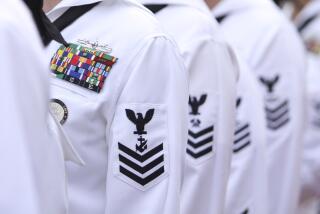Sailors Learn Sub Standards
- Share via
GROTON, Conn. — “Flooding in the engine room! Flooding in the engine room!” shouts Chief Machinist’s Mate Robert Jones.
Sirens wail as water pours into the replica of a submarine engine room, 1,200 gallons a minute and rising fast.
Eleven young sailors, all soaked to the skin, methodically apply rubberized metal patches to one pipe break after another. Inside the chamber, the noise is deafening.
“Flooding and fire are the two greatest fears aboard a submarine,” explains Jones, 30, a damage control instructor from Newton, Iowa. “Teamwork is essential in emergencies like this. They cannot panic. They have to be constantly alert and not be slammed against a wall and seriously hurt by water jettisoning from those pipes.”
While the fake engine room was flooding, sailors in other parts of the “sub” battled training fires; still others learned the intricacies of maneuvering a submerged vessel.
It was a typical day at the U.S. Naval Submarine Base New London at Groton, where 2,400 officers and enlisted personnel are enrolled in 345 different basic and advanced training courses that prepare them for life aboard nuclear-powered submarines. Sailors spend at least a year here before being assigned to ships that quietly “sail” the sea floor.
America’s “Silent Service,” as the submarine force is called, is celebrating its 90th birthday this year. And Groton is Sub City USA.
Every member of the submarine force spends time at Groton, either for basic training or for refresher courses.
There are 55,000 sailors, all men, in the submarine service, with 17,560 serving aboard America’s 123 active nuclear-powered submarines at any given time. Many are assigned to the 16-submarine Atlantic Fleet, whose base is in Groton, one of seven such bases. The others are in Holy Loch, Scotland; Bangor, Wash.; Norfolk, Va.; King’s Bay, Ga.; Pearl Harbor, Hawaii; and San Diego.
For 41 years, the Naval Submarine Medical Research Laboratory at Groton has been studying and solving biomedical and behavioral problems peculiar to underseas operations.
The Naval Undersea Medical Institute here trains doctors and technicians to serve aboard submarines and treat diving-related medical problems onshore.
Groton also is the home of the U.S. Navy’s Submarine Museum and Library, the repository for documents and books recording the histories of the 755 submarines built since the keel of the 53-foot-long Holland was laid April 11, 1900.
The museum, which is open to the public, has fascinating displays of memorabilia, working periscopes and a control room. On permanent exhibit is the Nautilus, the world’s first nuclear-powered submarine and the first ship to sail under the North Pole.
Lt. Gerald Norbut, 33, of Glendale has been serving on destroyers for the last five years. “I worked in a Safeway store in Glendale. I wanted to see the world, so I joined the Navy,” he said.
Norbut recently transferred to the submarine service and is now taking the basic training course. “The pay is better, promotion is quicker. The sub service has a certain mystique. It’s an all-volunteer service. They accept only the top sailors in the Navy, the cream of the crop,” he said.
Capt. George Lear, 45, a U.S. Naval Academy graduate and Fresno native, is commander of the Naval Submarine School. In 23 years in the “Silent Service,” he has served on five submarines and skippered two.
“Our people are the very best. There’s no question about it. They’re doing something tremendously exciting, something vital to their nation’s continued existence, something only a handful of people in the world can do,” Lear said.
He talked about the high standards of the sailors: “No one does drugs in the sub force. We are tested for drugs routinely, and no one is offended.
“An absolute requirement for every underseas sailor is to tell the truth at all times. You cannot put 150 people inside a pipe and take it at high speed to the bottom of the ocean unless you have total truth from every man about everything,” he said.
“Every sailor asks to come here. They have tremendous dedication, pride in country, pride in themselves.”
Home for submarine sailors, explained Lear, is a 292- to 425-foot-long cylinder.
“We have a strong sense of family living in a tight, confined space jammed with electronic gear. It is imperative we get along with one another.”
Of his job, Lear said: “I would have felt cheated if I had not spent my time on earth as a submariner. The high point of my life has been the 4 1/2 years I spent submerged in the ocean in a submarine.”
More to Read
Sign up for Essential California
The most important California stories and recommendations in your inbox every morning.
You may occasionally receive promotional content from the Los Angeles Times.













